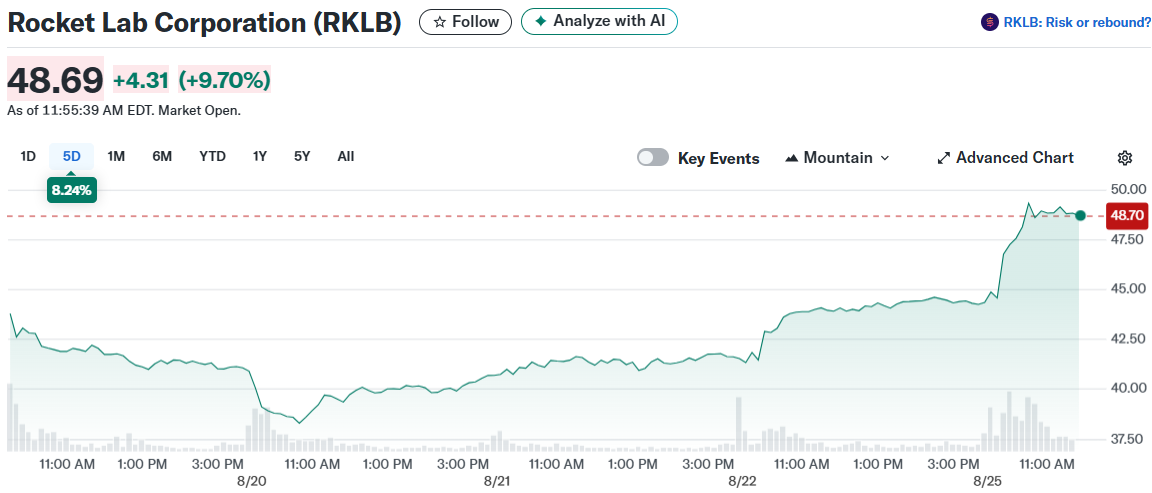TLDR
- Rocket Lab USA stock surged 10% following the successful completion of its 70th Electron mission launch
- The “Live, Laugh, Launch” mission marked Electron’s 12th launch of 2025, maintaining an accelerated launch schedule
- Company secured $23.9 million CHIPS Act funding to expand U.S. semiconductor manufacturing capacity
- Rocket Lab’s backlog has declined to $1 billion from $1.067 billion year-over-year, raising investor concerns
- Upcoming Neutron rocket launch will be crucial for competing with SpaceX’s Falcon 9 in the large launch vehicle market
Rocket Lab USA stock climbed 10% after the company successfully launched its 70th Electron mission on August 23. The “Live, Laugh, Launch” mission lifted off from Launch Complex 1 in Mahia, New Zealand.

This launch occurred less than three weeks after Electron’s previous successful mission from the same site. The rapid turnaround demonstrates the company’s ability to maintain an accelerated launch schedule.
The mission marks Electron’s 12th launch of 2025. The company has been executing launches at a brisk pace throughout the year.
Earlier this year, Rocket Lab set a record by conducting two launches just two days apart from Launch Complex 1 in late June. Most of this year’s Electron missions have been part of multi-launch contracts with satellite operators.
These contracts focus on deploying constellations in low Earth orbit. The consistent launch schedule has established Electron as the world’s most frequently launched small orbital rocket.
Government Funding Boosts Manufacturing Plans
Rocket Lab recently announced plans to expand its U.S. semiconductor manufacturing capacity. The company will receive a $23.9 million award through the Department of Commerce under the CHIPS and Science Act.
The funding supports investments aimed at providing supply chain security for space-grade solar cells. The money will also help produce electro-optical sensors for national security space missions.
Rocket Lab’s capital investments over the next five years are expected to strengthen its market position. The company is one of only two U.S. companies specializing in high efficiency, radiation hardened, space-grade compound semiconductors.
The company’s solar cells have powered major space missions. These include the James Webb Space Telescope and NASA’s Artemis lunar explorations.
Other missions using Rocket Lab solar cells include the Ingenuity Mars Helicopter and the Mars Insight Lander. This track record demonstrates the company’s role in critical space exploration projects.
Backlog Concerns Cloud Growth Story
Despite operational successes, Rocket Lab faces challenges with its contract backlog. The company reported $1 billion in backlog at the end of the second quarter of 2025.
This represents a decrease from $1.067 billion at the end of the first quarter of 2025. The backlog also declined year-over-year from $1.067 billion in the second quarter of 2024.
Management acknowledged that the company’s pipeline includes multi-launch deals and large satellite manufacturing contracts. They noted these opportunities can create lumpiness in backlog growth due to their size and complexity.
The year-over-year decrease in backlog has raised concerns among some investors. Analysts are watching to see if the company can reverse this trend in upcoming quarters.
For a growth company like Rocket Lab, securing future business is critical. The backlog serves as an indicator of future revenue potential.
Investors are also watching for the launch of Rocket Lab’s Neutron rocket this month. The Neutron represents the company’s entry into the large launch vehicle market.
Currently, SpaceX’s Falcon 9 dominates this market segment. A successful Neutron launch could attract customers who have been cautious about signing with Rocket Lab for larger missions.
The Neutron rocket will compete directly with established players in the heavy-lift launch market. Success in this segment could drive future backlog growth and revenue expansion.


